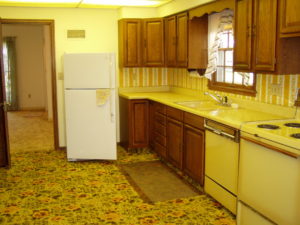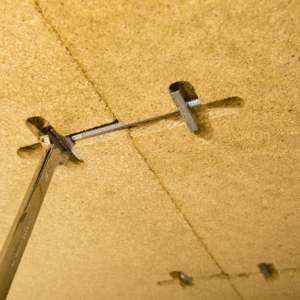Best Countertops for Rental Properties- Laminate
Are laminate countertops a good option to install in a rental property? Will it endure or crumble under the often harsh hand of the renter chef? Will laminate countertops give a good bang for their buck?
To help new or experienced real estate investors find the best option for their unit, this article series will go in depth into the main countertop materials. Today we start with Laminate, also known as Formica or Wilsonart. It is a low cost option which can be DIY installed in an afternoon.
History and Construction of Laminate Countertops:

If you had a childhood before the year 1990, you remember laminate countertops. Largely known as Formica, your parents probably had them in a single color which was probably ugly by today’s standards. Today’s laminate countertops are much better looking than their 80’s counterparts, but are they a good option for your rental kitchen?
Laminate countertops are produced in a similar manner to laminate flooring. Basically it is a hard layer of plastic over an engineered wood base. The laminate itself is composed of the following layers:
- Backing material which is glued to the substrate (usually particle board)
- Core material: The bulk of the laminate layer. This layer acts as a shock absorber for the rest of the laminate layer.
- Kraft paper: Provides depth to the image layer resting above it. Without this layer, the imitation stone products would look exceptionally fake.
- Print layer: The decorative layer with the image printed on it.
- Protective Top Layer: This layer gives a hard barrier between tenants and the layers below it.
Nifty hardware for laminate countertop miters.
Average Cost of Laminate Countertops:
In terms of cost, laminate is the least expensive option you can buy. There are cheaper options you can DIY, and maybe we will get to that in another post in the future.
As of mid 2018, using Home Depot as a reference point, the price is roughly $1-$2 per linear foot. So for a 30 linear foot kitchen, it will cost $300-$600 to purchase the counter material. That seems a pretty fair bargain if you are on a budget. Along with the actual counter, you will also need screws, liquid nail, a jigsaw to cut the sink hole, and a sealant for the seams. So, add $50 to your total, and you are still replacing a counter at minimal costs compared to the solid options, if you decide to install it yourself.
Several factors will affect the price of the a laminate countertop. The quality of the image will be the main factor. A cheap image will look “papery” and reduce the WOW factor of the countertops quickly. The edge of the countertop, if it has a build in backsplash, and the height of the backsplash will also affect the price of the product.
Installation of Laminate Countertops:
Depending on the configuration of your kitchen and how many pieces you need, you will most likely need a truck to transport your pieces from the store to your kitchen. Compared to other materials, laminate countertops are close to the lightest option, but carrying a ten foot pieces of anything is unwieldy. I recommend having a friend help with moving the pieces to avoid busted backs or windows.
Unlike materials like granite or quartz, laminate countertop installation requires a few more tools to complete.
Tool List:
- Power drill
- Circular Saw with trim blade
- Rubber mallet
- Level
- Scribe (optional but recommended)
- Belt sander (also optional)
A simple installation requires a circular saw to cut pieces to the length of the run. Use a guide to ensure the saw cuts a straight line. Always cut the straight cuts as opposed to the mitered side since the mitered cuts require special machinery to do correctly.
The drill will be used to connect the countertop to the top of the cabinets via corner brackets. Be careful to purchase the correct length screws so you don’t go through.
The rubber mallet is used to set the miter joint straight when tightening the miter bolts. You can use your fist, but I wouldn’t recommend it. A special glue is used to glue the seam and the miter bolts are used to cinc

h the seam together. I don’t suggest silicone for the seam. While it seems it should be a better sealant to keep out liquids, it leaves a sticky residue which will need to be scraped off with a razor. I recommend the glue.
Finally, the scribe and belt sander are used to match the edge to the wall if it isn’t exactly true. See the above video for these steps as they are plainly described and shown.
Moisture is the main enemy of the laminate countertop. If a significant amount of moisture comes in contact with the MDF/particleboard underside, it will swell and flake. It is a critical step to ensure the seams and the sink are properly seated and sealed. If they are not properly sealed, you may as well plan to replace this countertop annually. Dishwashers also require a special moisture barrier to be installed above the unit. The steam generated by the dishwasher’s operation will accumulate under the countertop. Without the moisture barrier installed, the steam will damage the countertop from underneath and ruin it over time.
Durability of Laminate Countertops:
Durability is the main weakness of laminate countertops. The base material is prone to water damage and exposing the underside of a laminate countertop will cause it to expand and bubble. As the laminate layer is essentially a plastic sheet; age, chemicals, and sunlight can cause discoloration and brittleness. Abrasions in the surface are also highly visible and virtually unrepairable, bringing down the “WOW” factor of even a nice laminate surface quickly.
The premade laminate countertops can sit in the store for months before you purchase it. Problematically, the big box stores do not seem to store them correctly horizontally, which sort of makes sense since they can be pretty big. However, while they are stored vertically or at even a slight angle gravity will work its magic and cause this product to warp. This is the main negative review of these products and should be considered when purchasing. They may settle back into relative straightness while sitting in the house, and can be pulled to the cabinet top with screws.
Conclusion:
Laminate countertops have come a long way since their heyday in the 90’s. The look and feel is drastically improved due to improved printing technology. However, the durability versus stone counterparts is lacking and repairs cannot be made to the surface. The WOW factor is less than most countertops as well.
These countertops will serve in a financial pinch, if you are over budget and need to cut something. However if you have the budget to get granite, the durability is probably worth it.